Off-Season Golf Practice Plan for Home or Indoors
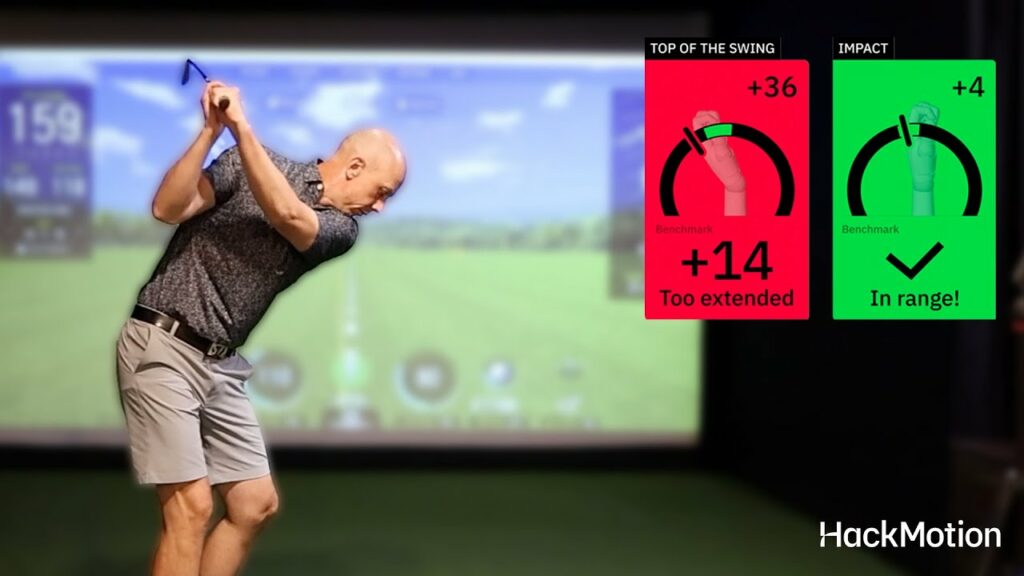
Get your personalized at-home golf practice plan with drills and tips designed for your available space and equipment. Perfect for off-season and winter training.


Get your personalized at-home golf practice plan with drills and tips designed for your available space and equipment. Perfect for off-season and winter training.

It’s time to stop thinking that winter is the end of the golf season. Let’s start calling it the “prep season” instead.
There is so much you can do to work on your golf game at home; it’s not necessary to put the clubs down and wait to use them again for a few months.
The key to effective winter golf practice is to have a routine and stick to it.
We have compiled a complete guide for at-home practice for your golf game.
You can choose your equipment and how that will impact what you can do. In addition, we included actionable drills so your practice this “slow season” is the most effective it’s ever been.
It won’t take you long to figure out that the most important part of winter golf practice is not the time you are putting in, but what you are doing during that time.
A 20-minute practice session is better than a one-hour session if you are working on the right things.
Create your tailored winter golf practice plan with just a few clicks. Get drills and tips based on your available space and equipment.
Choose your space and equipment below, and we’ll generate the perfect practice routine with drills tailored to your needs.
If you have a home golf simulator, you have the perfect setup for at-home practice and game improvement for the winter season. All golf simulators are different and offer access to unique technology and data.
When working with your at-home simulator, here is a basic plan for how you can get better this winter.
Break your full-swing practice into three sections, or three days’ worth of practice: clubface control, speed training, and ball flight or shot shaping practice.
Learning to control your clubface during the winter months is extremely beneficial. The wrists control the clubface in your golf swing.
Your main focus should be maintaining a flexed lead wrist at impact for crisper ball striking.
Here is the plan and the associated drills for working on clubface control in your golf simulator this winter.
The 9-to-3 drill is simple but effective, focusing on maintaining clubface control, body rotation, and proper wrist mechanics.
Although you can do this drill without the HackMotion, wearing your HackMotion will let you know if you are doing this correctly and practicing effectively.
Set your wrists as if you are already in the impact position. Keep your hands ahead of the ball and your lead wrist flat. Take some swings and try to match this impact position.
It’s fine to pause just after impact as if you are only taking half swings. Once you have that down, start hitting balls using this technique.
Set up two alignment sticks in front of the ball, one just inside and one just outside the target line, creating a “gate” for the ball to travel through.
Focus on hitting through the gate while keeping the clubface square.
Hit 15-20 shots, gradually narrowing the gate as you improve; check your results and the simulator data.
Select three different clubs (wedge, 7-iron, driver) and hit 10 shots with each, focusing on maintaining a square clubface at impact.
Review clubface angle data after each set to check for consistency.
Swing speed drills with a weighted club or device can help you gain more distance in the winter months.
Pair that practice with the proper workout and exercise regime and you’ll pick up some yards when you head back out on the course in the spring.
Establish your baseline by hitting ten shots with your 7 iron and then ten shots with your driver to get an idea of your current speed.
Make sure these swings are not purely about power; you want to just get a baseline, not test out your maximum speed. Pay close attention to speed, distance, and accuracy.
Overspeed training helps your body move faster using a lighter club or speed training stick.
If you don’t have a lighter club you can make this work by swinging an alignment stick. Work on swinging in sets of three.
Try 10 full-speed swings with balance and a fluid motion, making sure you record your speeds if possible.
Once you have worked on increasing your speed with the lighter club, it’s time to build up your strength with heavier golf clubs.
You can use a weighted club or attach weights to your clubs. Start with very small amounts and do this again in sets. Three sets of five to eight full swings is best.
Always check on your rotation and balance if you can’t keep them, lighten the weight or slow down the swing.
Now that you have done both your overspeed and power training, it’s time to move to your regular golf clubs and push yourself to swing a little fast.
See if you are able to increase speed from your initial base speed check. Keep the results of this practice session and watch how you develop through the winter.
Remember that even increasing your swing speed by two miles per hour can result in large distance gains.
Practicing your shot shaping is one of the best parts of owning a golf simulator.
Shot shaping practice can help take your game to the next level and have a huge impact on your scoring.
Work on shaping shots (fade, draw) by adjusting your swing path and face angle.
Play around with strong or weak grip positions depending on the results you are attempting to achieve.
Check your lead wrist position at impact. The more flexed you are, the easier it is to hit a draw. The more extended your lead wrist is, the easier it is to hit a fade.
Set up 10 shots where you attempt to hit a draw and 10 shots where you attempt a fade. Use the simulator to measure face angle, path, and spin rate to see if the desired shape is being produced.
Wear your HackMotion wrist sensor as you practice your shot shaping and pay close attention to the flexion/extension at impact.
Hit 10 shots where you attempt to vary the height of the ball flight. Focus on controlling dynamic loft at impact and adjusting trajectory based on the data.
Try to hit one shot low and the next high as you get better at this. This variation will help you become a lot better at controlling trajectory on the course.
Some golf simulators are not as effective with short game tracking and information. Regardless, you can implement this routine and drills to improve your short game practice.
When it comes to short game practice your best bet is to work on drills. Finding a variation of drills that help you make real progress on the course is your best option.
Here are some great ones to get started:
While practicing on your simulator driving range, set three targets at different distances (short, medium, long).
Use your simulator to hit 10 chips to each target, focusing on consistent contact and control over trajectory. Vary the club selection (wedge, sand wedge) for different shot types.
When you get really good at this, challenge yourself to use other clubs like the 9-iron, gap wedge, lob etc.
Set up targets at 20, 30, and 40 yards (adjust depending on your simulator’s setup or the common yardages you leave yourself on the course).
Hit 5 shots to each target, focusing on consistent carry distance. After each round, check the data for distance control and adjust your swing accordingly.
When you master this, switch clubs until you can be confident with all clubs in your bag.
Some golf simulators don’t offer much from a putting practice perspective. These at home putting drills you can do with or without the use of your simulator.
Make sure you do these consistently so you can ensure you are making progress.
Golfers who struggle with radial and ulnar deviation control in their putting stroke will love this drill. If you have a hard time keeping the putter on the proper path as you swing it back your wrists could be the culprit.
You’ll need a chopstick and a coin for this drill and if you have the HackMotion you’ll be able to record some valuable data.
For this drill you’ll need to be able to get an alignment stick to stand up.
Alignment stick holders are a great investment for indoor golf simulator practice.
Your alignment stick will work as your reference point ensuring you have a consistent setup and you can return the putter to the correct impact position each time.
Steering is a common issue for golfers. Instead of allowing for the natural rotation of the putter head, some golfers second guess themselves and steer to get the putter started on the right line.
You can use a laser or even just an aiming point, in addition to your HackMotion to learn to avoid steering and let the putter head naturally rotate.
Not everyone has the room or the budget for a golf simulator room in their home.
If you are able to swing and hit balls into a golf net, you can still make plenty of progress in your home golf practice routine.
For effective full swing practice it’s great to have a net to hit into. Even though you won’t be able to track your entire ball flight, it does help to get a feel for how the ball came off the face.
In addition, you’ll want to make sure you have the HackMotion on during your practice so you are recording some data.
For at home practice, work on clubface control, speed training and consistency of strike.
The wrists control your golf clubface. The more control you have over your wrists and their action, the easier it is to strike the ball with power and consistency.
Here are the best ways to work on clubface control at home.
For this drill, you’ll try to stop your golf club just after impact. To do this, you’ll need both strength and the proper positioning of your wrists.
Hit 10 to 15 shots, focusing on stopping the club when it is parallel to the ground just after impact.
Wear HackMotion to check on excessive rolling or twisting of the clubface.
Many golfers are unaware of the position of their clubface at any given point in the golf swing. The easiest way to start to learn what the club is doing is to exaggerate the open and closing of the face through impact.
Hit 10 shots where you deliberately feel like you increase wrist flexion through impact. Then take another swing where you feel like you increase wrist extension.
Stabilizing the wrist helps improve clubface control. To do this drill, you’ll grip the club with one arm. Take a backswing, and as you swing back down to the ball, focus on closing the clubface, as we call the Motorcycle move.
Rotate your body through the swing while keeping this flexion in the lead wrist. After impact, ensure the club brushes the ground.
Not only will you develop more awareness of the clubhead, but you’ll also eliminate some of your issues with hooks and slices.
Even if you don’t own a simulator, you can incorporate golf technology into your at-home practice.
In fact, to stay more engaged, some interactive practice with HackMotion can help.
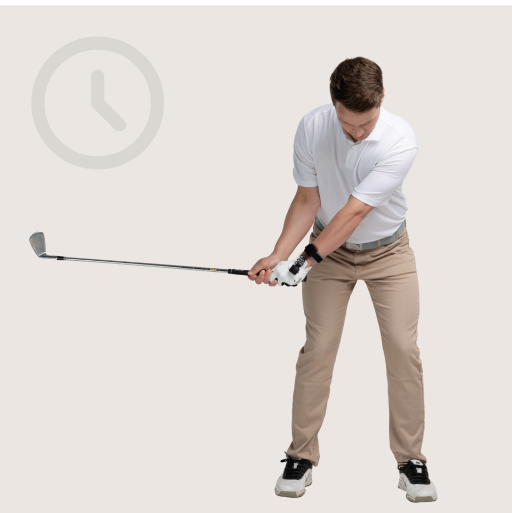 Level 1
Release drill
Train your release before working on other aspects of your swing
Level 1
Release drill
Train your release before working on other aspects of your swing
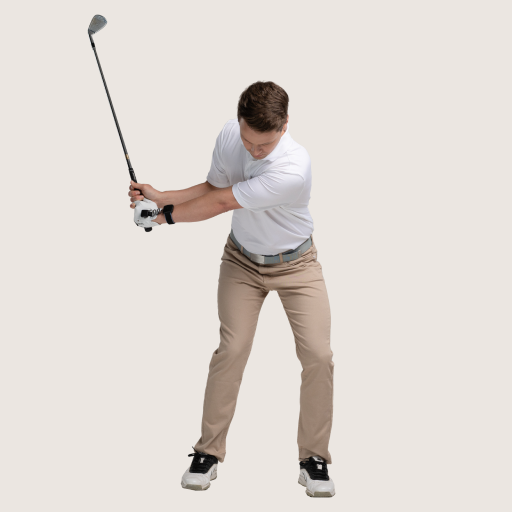 Level 2
Dynamic transition drill
Train your sequencing and pivot, as well as punch shots or your wedge game
Level 2
Dynamic transition drill
Train your sequencing and pivot, as well as punch shots or your wedge game
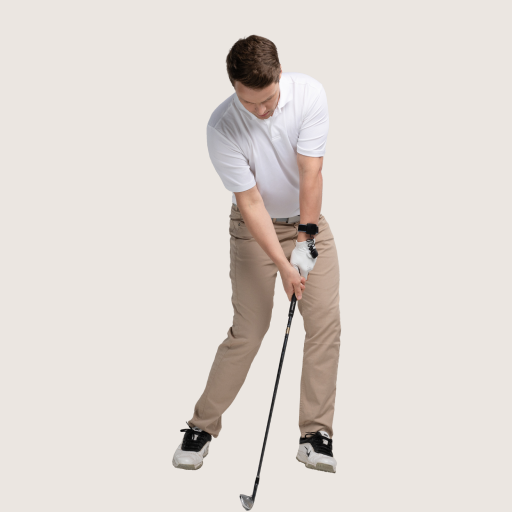 Level 3
Impact full swing challenge
Train your maximum power swing
Level 3
Impact full swing challenge
Train your maximum power swing
The 9-to-3 drill, 10-to-2 drill, and Motorcycle drill will help you dial in your wrist action with timely and accurate feedback.
The 9-to-3 drill is simple but effective, focusing on maintaining clubface control, body rotation, and proper wrist mechanics.
Once you have the 9-to-3 drill down, you can move on to the 10-to-2 drill.
The 10-to-2 drill will add more body rotation and get to a more complete release position.
The motorcycle drill is one of the most effective golf swing drills, from finding the correct location of your hands at the top of the backswing.
With the motorcycle drill you’ll be able to get the feeling of moving towards flexion on the downswing. The motorcycle drill gives you the feeling of revving a motorcycle at the top of the backswing.
Swing speed drills with a weighted club or device can help you gain more distance in the winter months.
Pair that practice with the proper workout and exercise regime and you’ll pick up some yards when you head back out on the course in the spring.
If you have a device that can track swing speed, your speed training sessions will be more beneficial.
Establish your baseline by hitting ten shots with your 7 iron and then ten shots with your driver to get an idea of what your current speed is.
Make sure these swings are not purely about power, you want to just get a baseline not test out your maximum speed. Pay close attention to speed, distance and accuracy.
Overspeed training helps your body move faster using a lighter club or speed training stick.
If you don’t have a lighter club you can make this work by swinging an alignment stick.
Work on swinging in sets of three. Try 10 full speed swings where you have balance and a fluid motion making sure you record your speeds if possible.
Once you have worked on increasing your speed with the lighter club, it’s time to build up your strength with heavier golf clubs. You can use a weighted club or attach weights to your clubs. Start with very small amounts and do this again in sets.
Three sets of five to eight full swings is best. Always check on your rotation and balance if you can’t keep them, lighten the weight or slow down the swing.
Now that you have done both your overspeed and power training, it’s time to move to your regular golf clubs and push yourself to swing a little fast. See if you are able to increase speed from your initial base speed check.
Keep the results of this practice session and watch how you develop through the winter. Remember that even increasing your swing speed by two miles per hour can result in large distance gains.
If you ever have days on the course where you feel like you can’t get two shots to feel the same, you need to work on your consistency.
The goal here is to maintain a repeatable wrist position and feel for solid contact.
To get the most out of your consistency practice, focus on these drills.
You should work with your HackMotion on while doing this drill so you have data as to how consistent your impact position is.
Take a 7 iron and hit 3-5 shots to establish a baseline for your wrist position at impact. The goal is to have a flat or slightly flexed lead wrist at impact.
When you are not within this range, set your HackMotion feedback to alert you and ensure you have your wrists in the proper position.
Many golfers struggle with consistency when switching from one swing to the next. If you feel like that transition from driver to 7-iron throws you for a loop, give this drill a try.
Hit five shots with your drive, five with your 7-iron and then five with your wedge. Once you do that, hit four shots with your driver, four with your 7-iron and four with your wedge.
Continue this pattern until you get to the single shot for each and then continue that for as long as your practice time allows.
You’ll have no choice but to make the necessary adjustments for stance, setup, wrist action, etc.
We all talk about the lead arm and the lead wrist position in the golf swing, but the trail arm can not be forgotten about.
The trail arm position will allow for a better approach to the ball, a correct swing plane, and better wrist action.
This video gives you some great tips and tricks for getting your right elbow setup correctly from the start and then keeping it in place as you strike the ball.
Practicing your short game at home is easiest if you have room to work with about 15 to 20 yards.
Hitting into a net does not give you quite as much feedback because you can’t look at things like ball flight and spin.
Place a bucket or target about 10-15 yards away and hit a sand wedge to try and land it in the bucket. Switch to your gap wedge, lob wedge and even your pitching wedge and see if you can get it in the bucket.
This drill is all about controlling the distance, you aren’t working on spin or roll out here so you’ll need to perfect this drill on the course and see how far everything rolls out. You’ll notice trajectory control is very important here.
Since you have already worked on controlling distance, you should now focus on getting a ball to stop where you want it to.
Of course, this will change depending on green speeds, slope, etc. However, the key is to learn control.
Place a towel flat on the ground about 5 yards away from you. Chip shots and try to get them to land on the towel.
When you get that down, move it to 10 yards, put it in an area on a bit of a slope, etc. Change the difficulty level.
The idea is if you can get the ball to stop on the towel you could also make a putt that length!
Golf putting practice is the easiest thing to work on at home. With golf putting practice you can use a putting mat or a carpet.
Golfers who struggle with radial and ulnar deviation control in their putting stroke will love this drill. If you have a hard time keeping the putter on the proper path as you swing it back your wrists could be the culprit.
You’ll need a chopstick and a coin for this drill and if you have the HackMotion you’ll be able to record some valuable data.
For this drill you’ll need to be able to get an alignment stick to stand up.
Alignment stick holders are a great investment for indoor golf practice.
Your alignment stick will work as your reference point ensuring you have a consistent setup and you can return the putter to the correct impact position each time.
Steering is a common issue for golfers. Instead of allowing for the natural rotation of the putter head, some golfers second guess themselves and steer to get the putter started on the right line.
You can use a laser or even just an aiming point, in addition to your HackMotion to learn to avoid steering and let the putter head naturally rotate.
If you have two alignment sticks and a rubber band, you have all you need to create a unique golf putting aid.
To keep a consistent and pendulum-like stroke, tie a rubber band around the end of two alignment sticks.
Put the alignment sticks under each of your arms and then grip them and take your putting stroke. You’ll feel how simple the motion is and how little wrist action there is.
If you have no room to take full swings with a golf club in your winter practice space you can still work on positions of your hands and wrists throughout the winter. In addition, you should be able to work on your putting routine.
Here are some great drills to practice. You can take slow-motion swings, use just your hands and no club, and develop some awareness of where the club is. You can also head outside and use some of these, even with no net to hit golf balls into.
Creating some muscle memory is a great way to get through the winter golf season.
Another great thing to work on is your train arm and wrist position. The trail arm takes a backseat to the lead wrist and lead arm but the positioning is very important.
If you’ve always wondered exactly what that trail elbow is supposed to do this Rob Cheney video will straighten things out for you.
Even if you don’t have room to swing a club, here are some core-strengthening exercises you can try.
Start slow with these and eventually increase difficulty.
Start in a plank position with your forearms on the ground. Engage your core and slowly lift one arm straight out in front of you. Hold for a few seconds and then return the arm to the ground and repeat with the other arm.
Try three sets of 10-12 reps per arm.
Sit on the floor with your knees bent and feet flat. Lean slightly back and hold a weight. Rotate your torso to one side than the other while keeping your core engaged. You’ll build rotational strength and be able to generate more power.
Try three sets of 15–20 reps per side.
Lie on your back with your arms extended toward the ceiling and your knees bent at a 90-degree angle. Lower your right arm and left leg towards the floor, return to the start and do it again. This is a great exercise for creating stability in the core.
Try three sets of 10–12 reps per side.
If you have not started to train your wrists in your golf game, the winter is a perfect time to start.
Your wrists control the clubface, and inconsistencies in your wrist action can lead to ball flight, distance, and direction mistakes.
Here are three interactive wrist control drills you can practice at home without a simulator.
The 9-to-3 drill is simple but effective, focusing on maintaining clubface control, body rotation, and proper wrist mechanics.
Once you have the 9-to-3 drill down, you can move on to the 10-to-2 drill.
The 10-to-2 drill will add more body rotation and get to a more complete release position.
The motorcycle drill is one of the most effective golf swing drills, from finding the correct location of your hands at the top of the backswing.
With the motorcycle drill you’ll be able to get the feeling of moving towards flexion on the downswing.
The motorcycle drill gives you the feeling of revving a motorcycle at the top of the backswing.
Here is what a guided drill sequence looks like in the HackMotion app.
 Level 1
Release drill
Train your release before working on other aspects of your swing
Level 1
Release drill
Train your release before working on other aspects of your swing
 Level 2
Dynamic transition drill
Train your sequencing and pivot, as well as punch shots or your wedge game
Level 2
Dynamic transition drill
Train your sequencing and pivot, as well as punch shots or your wedge game
 Level 3
Impact full swing challenge
Train your maximum power swing
Level 3
Impact full swing challenge
Train your maximum power swing
If you are looking for additional ways to work on your swing without even having to hit golf balls, take a look at some of these from Rob Cheney.
He walks through how to use alignment sticks and even a Divot Board to improve your ball striking and consistency, all while practicing at home.
Golf putting practice is the easiest thing to work on at home.
With golf putting practice you can use a putting mat or a carpet.
Golfers who struggle with radial and ulnar deviation control in their putting stroke will love this drill. If you have a hard time keeping the putter on the proper path as you swing it back your wrists could be the culprit.
You’ll need a chopstick and a coin for this drill and if you have the HackMotion you’ll be able to record some valuable data.
For this drill you’ll need to be able to get an alignment stick to stand up. Alignment stick holders are a great investment for indoor golf practice.
Your alignment stick will work as your reference point ensuring you have a consistent setup and you can return the putter to the correct impact position each time.
Steering is a common issue for golfers. Instead of allowing for the natural rotation of the putter head, some golfers second guess themselves and steer to get the putter started on the right line.
You can use a laser or even just an aiming point, in addition to your HackMotion to learn to avoid steering and let the putter head naturally rotate.
If you have two alignment sticks and a rubber band you have all you need to create a unique golf putting aid. To keep a consistent and pendulum-like stroke, tie a rubber band around the end of two alignment sticks.
Put the alignment sticks under each of your arms and then grip them and take your putting stroke. You’ll feel how simple the motion is and how little wrist action there is.
Now that you have some basics of what to do for your at home golf practice, here are some ways to break this practice down a bit more based on your handicap level.
If your goal is to come out of a winter or off-season with a lower handicap, here are the things you can focus on.
Higher handicap golfers need to prioritize consistency.
Working on drills that help promote stability in the wrists and improved balance will have the greatest impact on your game.
Use the HackMotion Static Top Drill and Static Release Drills to train yourself to reach the correct positions.
Another common issue that higher handicappers may run into is hitting behind the golf ball or hitting thin iron shots.
There are specific drills you can work on in the off-season to improve ball striking.
Higher handicap golfers tend to suffer from issues like hitting behind the golf ball or hitting thin shots.
This inconsistency in the ball strike can make golf very frustrating.
If you feel like you can’t compress the ball and strike it cleanly, try these drills to fix your thin shots.
Fat shots are score killers. Your club strikes well before the ball, and the total distance the ball travels won’t get you to your target.
If your standard miss is a fat shot, here are some great drills to fix it.
With a simple piece of masking tape you can start to learn exactly where your club is striking the ball and whether or not you need to make adjustments.
Practice this low point control drill without a golf ball in place at first.
Do you know what causes your shots to go left, right or straight?
The angle of the clubface at impact is the answer.
To have control over where the golf ball ends up, you need to learn to control this clubface at impact.
This drill is a great winter practice drill for learning clubface awareness.
Most high-handicap players complain about feel. They find that they struggle to have the feel and greenside touch necessary to get the ball close to the hole.
This throw-the-ball chipping drill will teach you how simple chipping mechanics can be if you learn to do it correctly.
Even if you don’t have much room to work on putting at home, you should try to work on your distance control.
Set a towel up across the carpet and get the ball to stop on the towel.
Green speeds will change when you get out to the course in the spring, but this drill will help you learn how to adjust to speed.
Mid handicap golfers should work on learning to shape their shots, refining distance control, and building speed.
Instead of worrying so much about hitting the golf ball straight or repeating your swing, you want to learn to control what the golf ball does. You’ve reached this level!
You’ll notice that the better you get at golf, the more important it is to learn to control the clubface.
In this video, you’ll go through a few different drills to help you control the face through impact and feel comfortable with your ability to hit shots straight, left, and right of the target.
While working on your golf swing in the winter months, make sure you are practicing correctly.
If you struggle to ensure your setup is correct every time, try this distance from the golf ball drill and practice routine.
Do you know what a proper impact position should look like? Many amateur golfers make it more complicated than it is.
Use this impact fix drill to pre-set the impact position and then continue to work through it until you master it.
Use the HackMotion dynamic release drill to help learn how to make good contact on a short swing before adding more power.
The goal is to make sure that the wrists at the impact are flexed more than they are at the address.
 Level 1
Release drill
Train your release before working on other aspects of your swing
Level 1
Release drill
Train your release before working on other aspects of your swing
 Level 2
Dynamic transition drill
Train your sequencing and pivot, as well as punch shots or your wedge game
Level 2
Dynamic transition drill
Train your sequencing and pivot, as well as punch shots or your wedge game
 Level 3
Impact full swing challenge
Train your maximum power swing
Level 3
Impact full swing challenge
Train your maximum power swing
A very simple drill to set up the chipping plane can teach you a lot about the issues you may have in your chipping game.
Many players use their hands and wrists to get the club started on its path away from the ball.
Doing this causes inconsistency in the plane, but it can be fixed.
Everyone thinks about the importance of hitting golf shots in the center of the face of their drivers or irons.
However, striking the center of the putter face is just as important!
Use this middle-of-the-face putting drill to see how close you get to center strikes.
As a low handicap golfer you probably have a very good idea as to what you need to work on in your golf game.
Data becomes even more important for low handicap players.
Advanced data analysis using tools like HackMotion can give valuable insights into the club path, face angle, and ball flight of your golf shots.
Here are a few additional drills to work on:
If wrist action is something you have not thought much about in the past, start with these drills from Rob Cheney.
He will show you the exact patterns we have observed by studying more than 1,000,000 golfers, including the best in the world.
Great golfers have enough control of the club to control the location of the strike. Have you ever worked on hitting the ball closer to the heel or the toe of your iron?
Here’s a great way to work on taking control of the face.
Similar to controlling the location of your strike on the clubface, you should also be able to control the angle of the clubface at impact.
This drill is simple to set up and is a great way to practice and become comfortable with impact in the winter season.
Mid- to high handicappers need to work more on consistent contact, but as a low handicap player, you can start to play around with wrist action to produce different shot results.
If your short game should be more diverse with different types of shot outcomes, try learning some of these concepts.
Wrist mechanics in putting are more complicated than they seem.
Where some higher-handicap amateur players can just try to keep wrists quiet, low handicap players need to repeat the same wrist action to make the putts that count.
Using HackMotion to improve your wrist action in the putting stroke is simple and effective.
If you’ve been working through the drills included with the HackMotion app you’ll notice that there are both static and dynamic drills to work on.
For low-handicap players, the dynamic and full-swing challenge drills are going to be a little more difficult. You’ll have to maintain proper wrist position while hitting shots.
 Level 1
Release drill
Train your release before working on other aspects of your swing
Level 1
Release drill
Train your release before working on other aspects of your swing
 Level 2
Dynamic transition drill
Train your sequencing and pivot, as well as punch shots or your wedge game
Level 2
Dynamic transition drill
Train your sequencing and pivot, as well as punch shots or your wedge game
 Level 3
Impact full swing challenge
Train your maximum power swing
Level 3
Impact full swing challenge
Train your maximum power swing
Also, take advantage of the benchmark options available in full-swing free practice mode.
You can compare your shots against those of PGA Tour players or even a perfect swing of yours that you made earlier in the day.
If this is your first year committing to winter golf practice, take these tips from the seasoned veterans.
Here are the biggest mistakes golfers make in winter golf practice.
So many golfers who want to start an at-home practice plan don’t know where to start. Are you aware of your swing flaws and where the issues are in your game?
Here are a few tips to make sure you are diagnosing your swing faults correctly.
Hopefully, this complete guide on at-home and winter golf practice has left you in a better position to work on your golf game.
You’ll find you don’t need a real offseason when you play golf.
Simply take advantage of the opportunities you have at home and be smart about incorporating the right tools, like HackMotion, into your at-home practice routine.
Looking for more content on how to structure your practice sessions?
Go here for an Interactive Driving Range Practice Plan and an 8-Week Golf Tournament Practice Plan.
Please fill out our quick 3-question quiz to help us continue creating content that meets your needs. Your responses won’t be public, so feel free to be honest!
Train smarter with HackMotion—your personal coach on your wrist, guiding you to better shots, sharper mechanics, and real progress every time you practice.
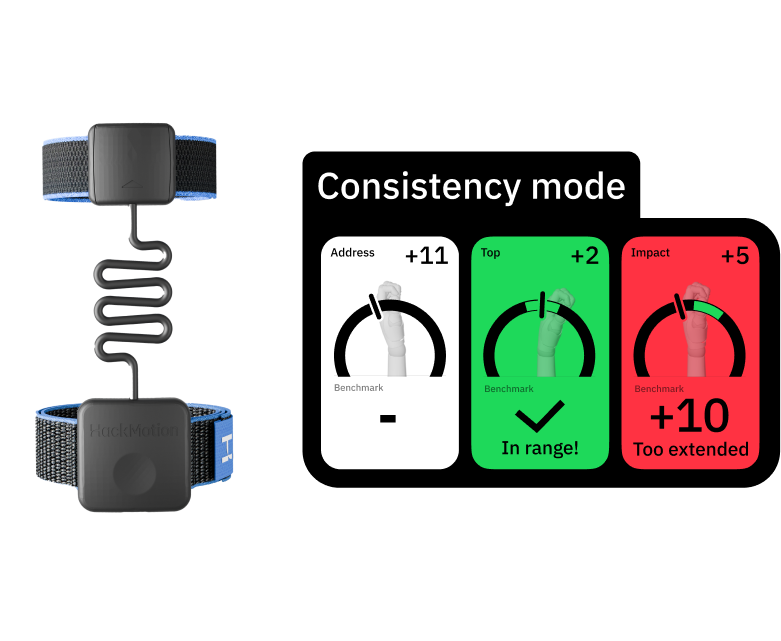
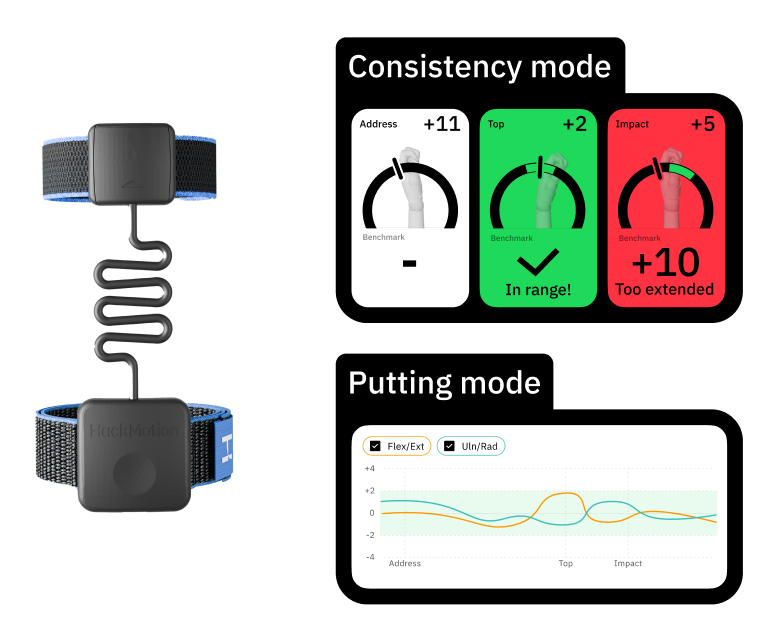
Copyright 2025 © HackMotion | All Rights Reserved